Deza M.M., Laurent M. Geometry of Cuts and Metrics
Подождите немного. Документ загружается.

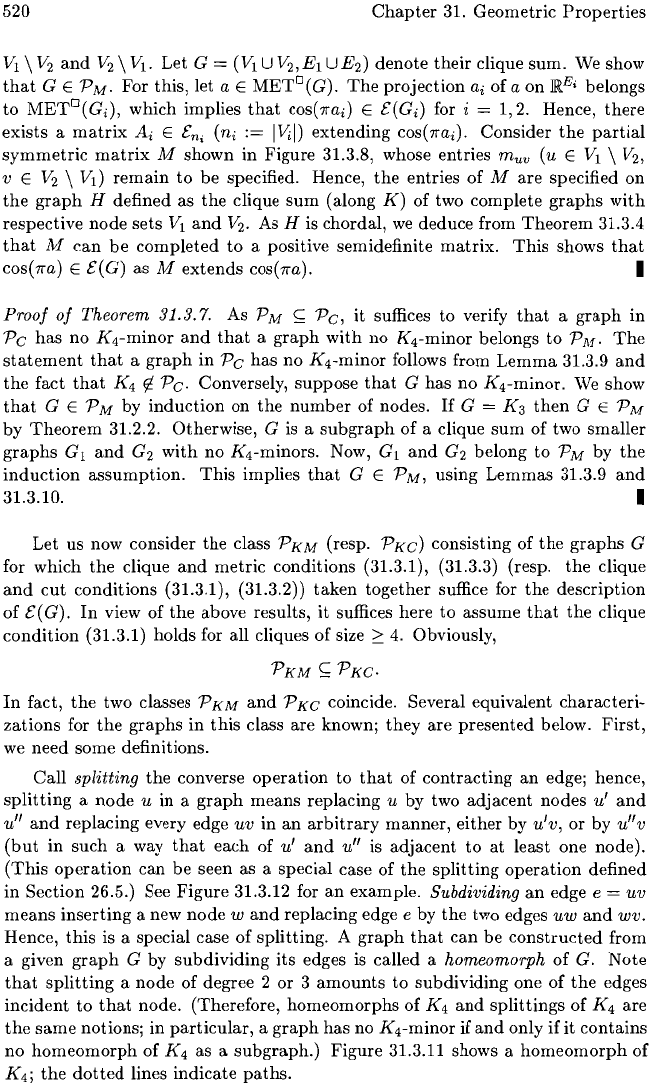
520
Chapter
31. Geometric
Properties
VI
\ V
2
and
V
2
\
VI.
Let G =
(VI
U V
2
,
El
UE
2
)
denote
their
clique
sum.
We show
that
G E PM. For this, let a E METO(G).
The
projection
ai
of a on
~E,
belongs
to
METO(G
i
),
which implies
that
COS(7rai)
E E(G
i
)
for i =
1,2.
Hence,
there
exists a
matrix
Ai
E
En,
(ni
:=
IViI)
extending
COS(7rai).
Consider
the
partial
symmetric
matrix
M shown in Figure 31.3.8, whose entries
muv
(u
E
VI
\
V2,
V E
V2
\
VI)
remain
to
be specified. Hence,
the
entries of M are specified on
the
graph
H defined as
the
clique
sum
(along
K)
of two complete
graphs
with
respective node sets
VI
and
V2.
As H is chordal,
we
deduce from
Theorem
31.3.4
that
M
can
be
completed
to
a positive semidefinite
matrix.
This
shows
that
cos(7ra) E E(G) as M extends cos(7ra). I
Proof
of
Theorem 31.3.7. As PM
S;;
Pc,
it suffices to verify
that
a
graph
in
Pc
has
no K4-minor
and
that
a
graph
with
no K
4
-minor
belongs
to
PM.
The
statement
that
a
graph
in
Pc
has
no K4-minor follows from
Lemma
31.3.9
and
the
fact
that
K4
rt
Pc.
Conversely, suppose
that
G has no K
4
-minor. We show
that
G E
PM
by
induction
on
the
number
of nodes.
If
G =
K3
then
G E PM
by
Theorem
31.2.2. Otherwise, G
is
a
subgraph
of a clique
sum
of two smaller
graphs
G
1
and
G
2
with
no K4-minors. Now, G
1
and
G2
belong
to
PM by
the
induction
assumption.
This
implies
that
G E PM, using Lemmas 31.3.9
and
31.3.10. I
Let us now consider
the
class
PKM
(resp. PKC) consisting of
the
graphs
G
for which
the
clique
and
metric conditions (31.3.1), (31.3.3) (resp.
the
clique
and
cut
conditions (31.3.1), (31.3.2))
taken
together suffice for
the
description
of
E (G).
In
view of
the
above results, it suffices here
to
assume
that
the
clique
condition
(31.3.1) holds for all cliques of size
:0::
4.
Obviously,
PKM
S;;PKC.
In
fact,
the
two classes
PKM
and
PKC coincide. Several equivalent characteri-
zations for
the
graphs
in
this
class are known; they are
presented
below.
First,
we
need some definitions.
Call
splitting
the
converse operation to
that
of contracting
an
edge; hence,
splitting
a
node
u in a
graph
means replacing u by two adjacent nodes u'
and
u"
and
replacing every edge
uv
in
an
arbitrary
manner, either by u'v, or by
u"v
(but
in such a way
that
each of
u'
and
u"
is
adjacent
to
at
least one node).
(This
operation
can be seen as a special case of
the
splitting
operation
defined
in Section
26.5.) See
Figure
31.3.12 for
an
example. Subdividing
an
edge e =
uv
means
inserting
a new
node
wand
replacing edge e by
the
two edges
uw
and
wv.
Hence,
this
is a special case of splitting. A
graph
that
can be
constructed
from
a given
graph
G by
subdividing
its
edges
is
called a homeomorph of G. Note
that
splitting
a
node
of degree 2 or 3
amounts
to
subdividing one of
the
edges
incident
to
that
node. (Therefore, homeomorphs of
K4
and
splittings
of
K4
are
the
same
notions; in
particular,
a
graph
has no K
4
-minor if
and
only if
it
contains
no
homeomorph
of
K4
as a
subgraph.)
Figure 31.3.11 shows a
homeomorph
of
K4;
the
dotted
lines indicate
paths.
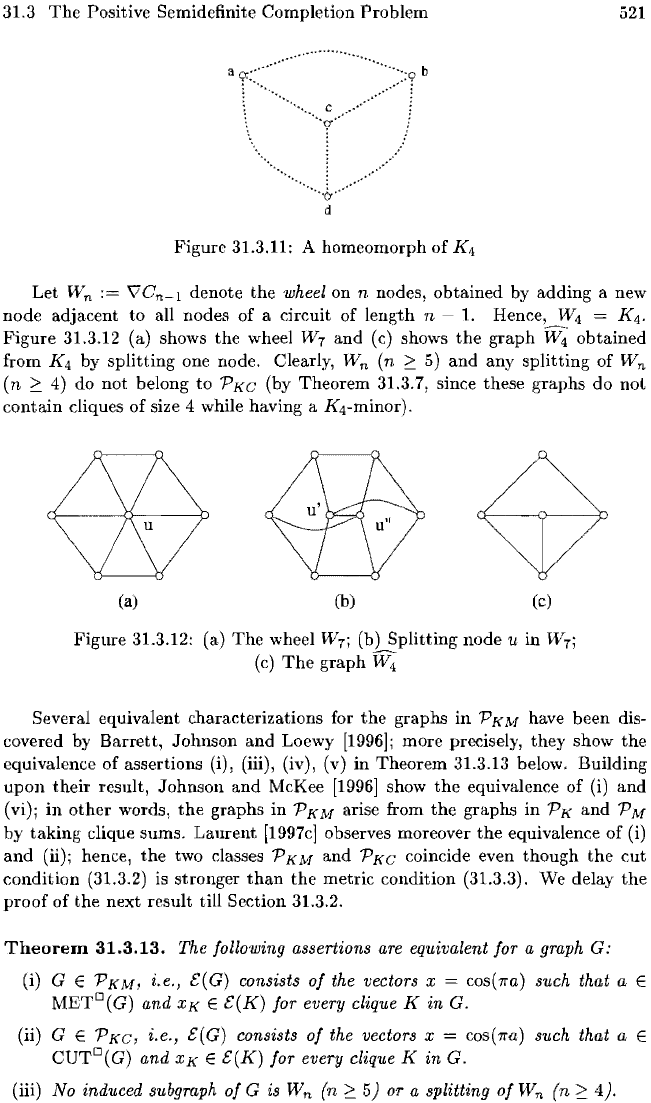
31.3
The
Positive Semidefinite Completion Problem
521
b
c
d
Figure 31.3.11: A homeomorph of K4
Let Wn
:=
V'C
n
-
1
denote the wheel on n nodes, obtained by adding a new
node adjacent to all nodes of a circuit of length
n
1.
Hence, W
4
= K
4
•
Figure 31.3.12 (a) shows the wheel
Wr
and (c) shows
the
graph W
4
obtained
from
K4 by splitting one node. Clearly, Wit (n
::::
5)
and any splitting of
Wn
(n
::::
4)
do not belong to
PKC
(by Theorem 31.3.7, since these graphs do not
contain cliques
of
size 4 while having a K
4
-minor).
(a)
(b)
(c)
Figure 31.3.12: (a)
The
wheel W
r
; (b) Splitting node u
in
W7;
(c)
The
graph
W
4
Several equivalent characterizations for the graphs
in
PKM
have been dis-
covered by
Barrett,
Johnson and Loewy
[19961;
more precisely, they show the
equivalence
of
assertions (i), (iii), (iv), (v)
in
Theorem 31.3.13 below. Building
upon
their
result, Johnson and McKee
[19961
show
the
equivalence of (i) and
(vi);
in
other
words,
the
graphs in
PKM
arise from the graphs in
PK
and
PM
by
taking
clique sums. Laurent
[1997c]
observes moreover
the
equivalence of
(i)
and
(ii)j the two classes
PKM
and
PKC
coincide even though
the
cut
condition (31.3.2) is stronger
than
the metric condition (31.3.3).
We
delay
the
proof
of
the next result till Section 31.3.2.
Theorem
31.3.13.
The following assertions are equivalent for a graph
G:
(i) G E
PKM,
i.e., e(G) consists
of
the vectors x = cos(1l'a) such that a E
METD(G)
and
XK
E
e(K)
for every clique K in G.
(ii) G E
PKC,
i.e., e(G) consists
of
the vectors x =
cos(1l'a)
such that a E
CUTD(G) and
XK
E
e(K)
for every clique K
in
G.
(iii) No induced subgraph
of
G is
Wn
(n::::
5)
or a splitting
of
Wn
(n::::
4).
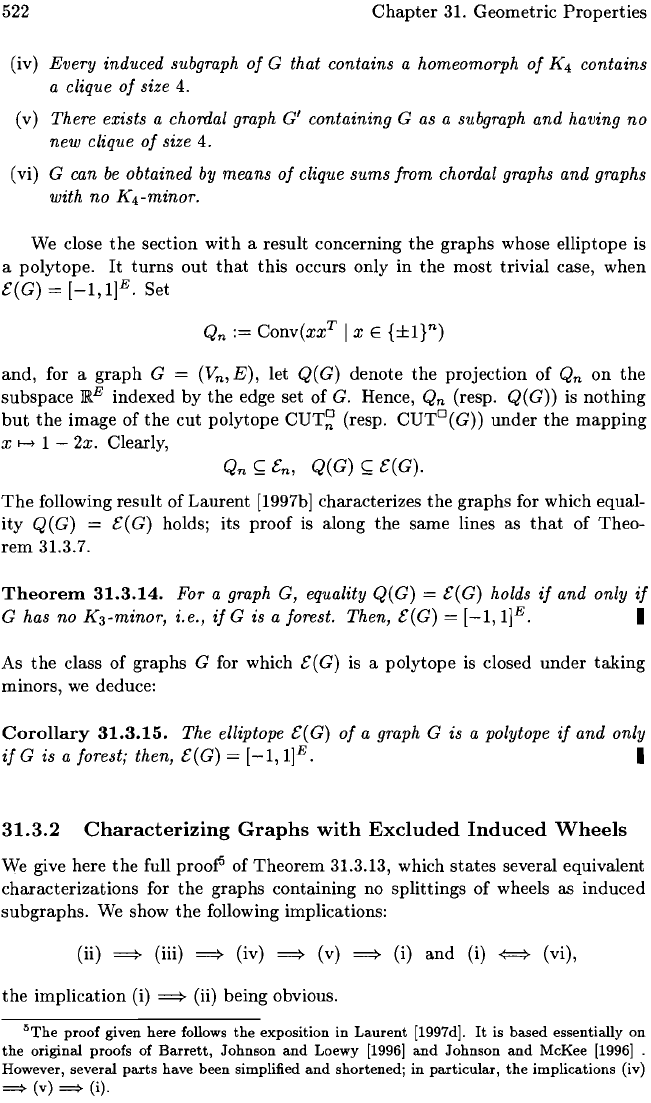
522
Chapter
31. Geometric
Properties
(iv)
Every
induced subgraph
of
G that contains a homeomorph
of
K4 contains
a clique
of
size
4.
(v) There exists a chordal graph
G'
containing G as a subgraph
and
having
no
new
clique
of
size 4.
(vi) G can
be
obtained by means
of
clique
sums
from chordal graphs and graphs
with
no
K
4
-minor.
We close
the
section
with
a result concerning
the
graphs
whose elliptope is
a
polytope.
It
turns
out
that
this
occurs only in
the
most
trivial
case,
when
E(G) = [-I,I]E. Set
and,
for a
graph
G =
(V
n
,
E),
let
Q(
G) denote
the
projection
of
Qn
on
the
subspace
]RE indexed by
the
edge set
of
G. Hence,
Qn
(resp.
Q(G))
is
nothing
but
the
image
of
the
cut
polytope
CUT~
(resp. CUTD(G))
under
the
mapping
x
I->
1 - 2x. Clearly,
The
following
result
of
Laurent
[1997b] characterizes
the
graphs
for which equal-
ity
Q (G) = E (G) holds; its
proof
is
along
the
same
lines as
that
of
Theo-
rem
31.3.7.
Theorem
31.3.14.
For a graph G, equality Q(G) = E(G) holds
if
and only
if
G has no
K3-minor,
i.e.,
if
G is a forest. Then, E(G) =
[-I,
I]E.
I
As
the
class
of
graphs
G for which E(G)
is
a
polytope
is
closed
under
taking
minors,
we
deduce:
Corollary
31.3.15.
The elliptope E(G)
of
a graph G is a polytope
if
and only
if
G is a forest; then, E(G) = [-1,
I]E.
I
31.3.2
Characterizing
Graphs
with
Excluded
Induced
Wheels
We give here
the
full
prooF
of
Theorem
31.3.13, which
states
several equivalent
characterizations
for
the
graphs containing no
splittings
of
wheels as
induced
subgraphs.
We show
the
following implications:
(ii)
==>
(iii)
==>
(iv)
==>
(v)
==>
(i)
and
(i)
-<=}
(vi),
the
implication
(i)
==>
(ii) being obvious.
'The
proof
given
here
follows
the
exposition
in
Laurent
[1997d].
It
is
based
essentially
on
the
original proofs of
Barrett,
Johnson
and
Loewy [1996]
and
Johnson
and
McKee
[1996] .
However,
several
parts
have
been
simplified
and
shortened;
in
particular,
the
implications
(iv)
~
(v)~
(i).
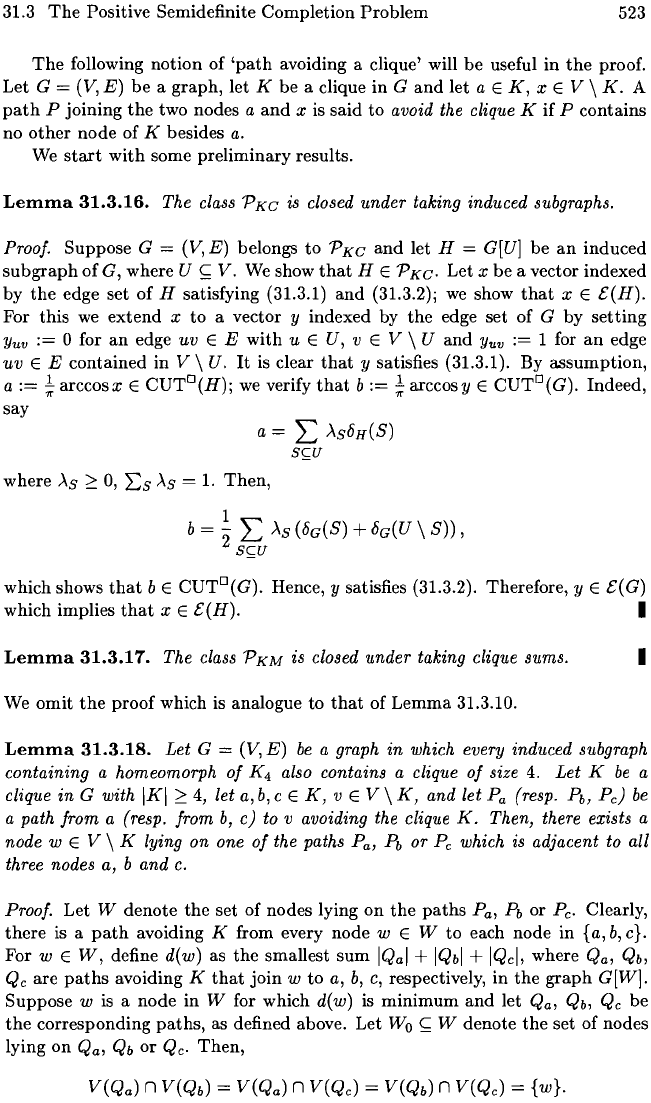
31.3
The
Positive Semidefinite
Completion
Problem
523
The
following
notion
of
'path
avoiding a clique' will
be
useful
in
the
proof.
Let
G = (V,
E)
be
a
graph,
let K
be
a clique
in
G
and
let a E
K,
x E V \
K.
A
path
P
joining
the
two nodes a
and
x is
said
to
avoid the clique K
if
P
contains
no
other
node
of K besides
a.
We
start
with
some
preliminary
results.
Lemma
31.3.16.
The class PKC is closed
under
taking induced subgraphs.
Proof.
Suppose
G = (V,
E)
belongs
to
PKc
and
let H = G[U]
be
an
induced
subgraph
of
G, where U
~
V.
We show
that
H E PKC.
Let
x
be
a vector
indexed
by
the
edge set
of
H satisfying (31.3.1)
and
(31.3.2);
we
show
that
x E
£(H).
For
this
we
extend
x
to
a vector y indexed by
the
edge set
of
G
by
setting
yuv
:=
0 for
an
edge
uv
E E
with
u E U, v E V \ U
and
Yuv
:=
1 for
an
edge
uv
E E
contained
in
V \ U.
It
is clear
that
y satisfies (31.3.1). By
assumption,
a:=
~
arccos x E
CUTD(H);
we verify
that
b:=
~
arccosy
E CUTD(G). Indeed,
say
where
AS
~
0, Ls
AS
= 1.
Then,
1
b = 2 L
AS
(oG(S)
+
0G(U
\ S)),
s~u
which shows
that
b E CUTD(G). Hence, y satisfies (31.3.2). Therefore, y E £(G)
which implies
that
x E
£(H).
I
Lemma
31.3.17.
The class
PKM
is closed
under
taking clique sums. I
We
omit
the
proof
which is analogue
to
that
of
Lemma
31.3.10.
Lemma
31.3.18.
Let
G =
(V,
E)
be
a graph
in
which every induced subgraph
containing a homeomorph
of
K4 also contains a clique
of
size 4.
Let
K
be
a
clique
in
G with
IKI
~
4, let a,
b,
c E
K,
v E V \
K,
and let P
a
(resp. Pb, Pc)
be
a path from a (resp. from
b,
c) to v avoiding the clique
K.
Then, there exists a
node
W E V \ K lying
on
one
of
the paths P
a
,
P
b
or
Pc
which is adjacent to all
three nodes a,
band
c.
Proof.
Let
W
denote
the
set
of
nodes lying
on
the
paths
P
a
,
Pb
or Pc. Clearly,
there
is a
path
avoiding K from every
node
W E W
to
each
node
in
{a,
b,
c}.
For W E
W,
define d(w) as
the
smallest
sum
IQal
+
IQbl
+
IQcl,
where Qa,
Qb,
Qc
are
paths
avoiding K
that
join
w
to
a,
b,
c, respectively,
in
the
graph
G[W].
Suppose
w is a
node
in
W for which d(w) is
minimum
and
let Qa,
Qb,
Qc
be
the
corresponding
paths,
as defined above.
Let
Wo
~
W
denote
the
set of nodes
lying
on
Qa,
Qb
or
Qc.
Then,
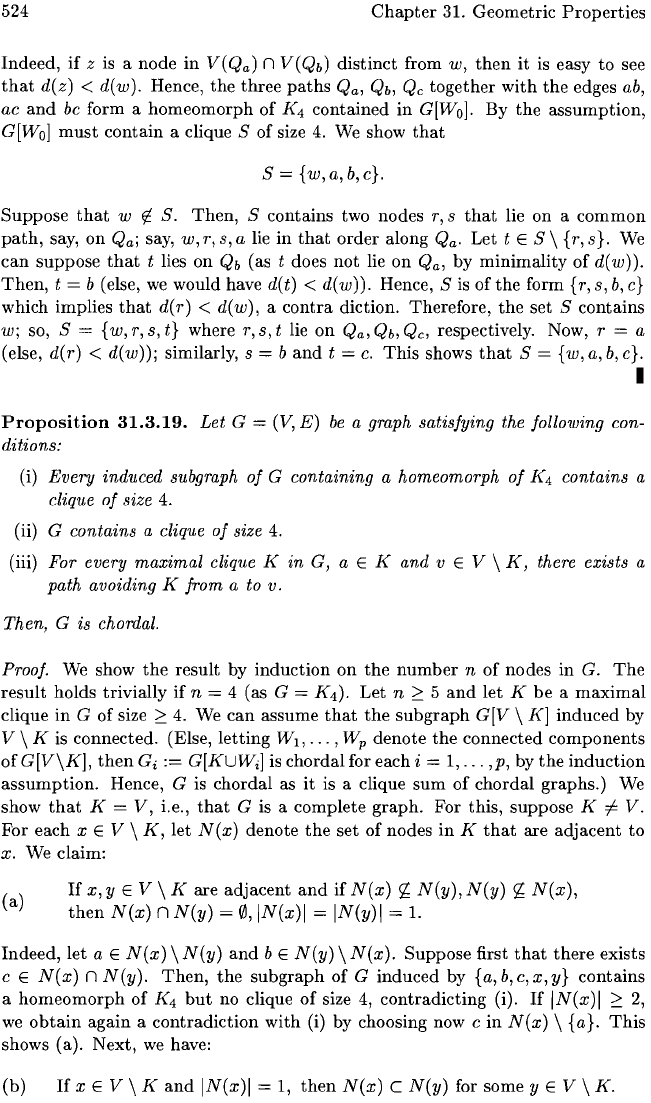
524
Chapter
31. Geometric
Properties
Indeed,
if
z
is
a node
in
V (Q
a)
n V (Qb)
distinct
from
w,
then
it
is
easy to see
that
d(z)
<
d(w).
Hence,
the
three
paths
Qa, Qb, Qc together
with
the
edges ab,
ac
and
bc form a
homeomorph
of
K4 contained
in
G[Wo].
By
the
assumption,
G[Wo]
must
contain a clique S of size 4. We show
that
S={w,a,b,c}.
Suppose
that
w
t/:.
S.
Then,
S contains two nodes r, s
that
lie on a
common
path,
say,
on
Qaj say,
w,r,s,a
lie
in
that
order along Qa. Let t E
S\
{r,s}.
We
can
suppose
that
t lies on
Qb
(as t does
not
lie
on
Qa, by
minimality
of
d(w)).
Then,
t = b (else,
we
would have
d(
t) < d( w)). Hence, S
is
of
the
form {r,
s,
b,
c}
which implies
that
d(r)
<
d(w),
a
contra
diction. Therefore,
the
set S contains
Wj
so, S =
{w,
r, s,
t}
where r,
s,
t lie
on
Qa, Qb, Qc, respectively. Now, r = a
(else,
d(r)
<
d(w))j
similarly, s =
band
t = c.
This
shows
that
S =
{w,a,b,c}.
I
Proposition
31.3.19.
Let
G =
(V,
E)
be
a graph
satisfying
the following con-
ditions:
(i)
Every
induced subgraph
of
G
containing
a
homeomorph
of
K4
contains
a
clique
of
size
4.
(ii) G
contains
a clique
of
size
4.
(iii) For
every
maximal
clique K
in
G, a E K
and
v E V \
K,
there exists a
path
avoiding
K
from
a to
v.
Then,
G is chordal.
Proof.
We show
the
result by
induction
on
the
number
n
of
nodes in G.
The
result
holds trivially
if
n = 4 (as G = K4). Let n
?:
5
and
let K
be
a
maximal
clique
in
G of
size?:
4.
We
can
assume
that
the
subgraph
G[V
\ K]
induced
by
V \ K is connected. (Else,
letting
WI,
...
,
Wp
denote
the
connected
components
of
G[V\K]'
then
G
i
:=
G[KUWi]
is chordal for each i =
1,
...
,p,
by
the
induction
assumption.
Hence, G
is
chordal as
it
is a clique
sum
of
chordal graphs.) We
show
that
K =
V,
i.e.,
that
G is a complete
graph.
For this, suppose K
=I-
V.
For each x E V \
K,
let
N(x)
denote
the
set
of
nodes
in
K
that
are
adjacent
to
x.
We claim:
(a)
If
x,
Y E V \ K are adjacent
and
if
N(x)
!J:.
N(y),
N(y)
!J:.
N(x),
then
N(x)
n
N(y)
=
0,
IN(x)1 = IN(y)1 =
1.
Indeed, let a E N
(x)
\ N
(y)
and
bEN
(y) \ N
(x).
Suppose first
that
there
exists
c
E
N(x)
n
N(y).
Then,
the
subgraph
of
G
induced
by
{a,b,c,x,y}
contains
a
homeomorph
of
K4
but
no clique
of
size
4,
contradicting (i).
If
IN(x)1
?:
2,
we
obtain
again a contradiction
with
(i) by choosing now c
in
N(x)
\
{a}.
This
shows (a). Next,
we
have:
(b)
If
x E V \ K
and
IN(x)1 =
1,
then
N(x)
C
N(y)
for some y E V \
K.
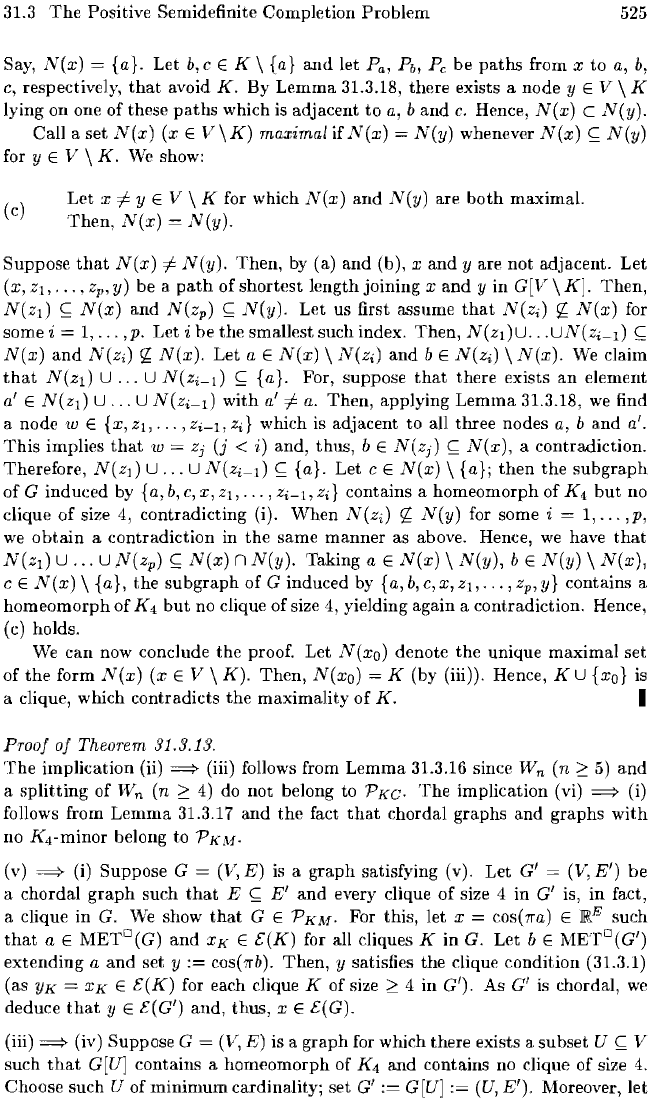
31.3
The
Positive Semidefinite Completion Problem
525
Say,
N(x)
=
{a}.
Let
b,
c E K \ {a}
and
let Pa, Pb,
Pc
be
paths
from x to a,
b,
c,
respectively,
that
avoid
K.
By Lemma 31.3.18, there exists a node y E V \ K
lying on one of these
paths
which is adjacent
to
a,
band
c.
Hence,
N(x)
C
N(y).
Call a set
N(x)
(x E
V\K)
maximalif
N(x)
N(y)
whenever
N(x)
<;;;
N(y)
for y E V \
K.
We
show:
(c)
Let x t- y E V \ K for which
N(x)
and
N(y)
are
both
maximaL
Then,
N(x)
N(y).
Suppose
that
N(x)
N(y).
Then,
by
(a)
and
(b), x
and
yare
not
adjacent. Let
(x,
Zl,'
..
,
zP'
y) be a
path
of shortest length joining x
and
y in
G[V
\
K].
Then,
N(Zl)
<;;;
N(x)
and N(zp)
N(y).
Let us first assume
that
N(z.)
)l
N(x)
for
some
i
1,
...
,po
Let i be the smallest such index. Then,
N(zI)u
...
UN(Z._l)
<;;;
N(x)
and
N(z.)
)l
N(x).
Let a E
N(x)
\ N(Zi)
and
bE
N(z.)
\
N(x).
We
claim
that
N(Zl) U
...
U
N(Zi-l)
<;;;
{a}. For, suppose
that
there exists
an
element
a' E N(Zl) U
...
U
N(Zi-l)
with a' t- a. Then, applying
Lemma
31.3.18,
we
find
a node
W E {x,
Zl,
...
, Zi-l, z;} which is adjacent to all three nodes a, b and a'.
This
implies
that
W
Zj
(j
< i) and, thus,
bE
N(zj)
<;;;
N(x),
a contradiction.
Therefore,
N(z])
U
...
U
N(Zi-l)
<;;;
{a}. Let c E
N(x)
\ {a};
then
the subgraph
of
G induced
by
{a,
b,
c,
x,
Zl,
...
,
Zi-l,
Zi}
contains a homeomorph of
K4
but
no
clique of size
4,
contradicting (i). When N(z;)
)l
N(y)
for some i =
1,
...
,p,
we
obtain
a contradiction in the same manner as above. Hence,
we
have
that
N(Zl)
U
...
U N(zp)
<;;;
N(x)
n
N(y).
Taking a E
N(x)
\
N(y),
bE
N(y)
\
N(x),
C E
N(x)
\ {a}, the subgraph of G induced
by
{a,
b,
c,
x, Zl, .
..
,zp,
y}
contains a
homeomorph of
K4
but
no clique of size 4, yielding again a contradiction. Hence,
(c) holds.
We
can
now conclude the proof. Let
N(xo)
denote the unique maximal set
of
the
form
N(x)
(x E V \
K).
Then, N(xo) = K (by (iii». Hence, K U {xo} is
a clique, which contradicts the maximality of
K.
I
Proof
of
Theorem 31.3.13.
The
implication
Oi)
~
(iii) follows from Lemma 31.3.16 since Wn
(n
2:
5)
and
a splitting of Wn (n
2:
4)
do not belong to
PKC.
The
implication (vi)
~
(i)
follows from
Lemma
31.3.17
and
the
fact
that
chordal graphs and graphs with
no K4-minor belong to
PKM.
(v)
~
(i) Suppose G =
(V,
E)
is a
graph
satisfying (v). Let G'
(V,
E')
be
a chordal
graph
such
that
E
<;;;
E'
and
every clique of size 4 in
G'
in fact,
a clique in G.
We
show
that
G E P
K1v
['
For this, let x
cos(-rra)
E such
that
a E METD(G) and
XK
E
elK)
for all cliques
Kin
G. Let
bE
METD(G')
extending
a
and
set y
:=
cos(1rb). Then, y satisfies the clique condition (31.3.1)
(as
YK
=
XK
E
elK)
for each clique K of size
2:
4 in G'). As
G'
is chordal,
we
deduce
that
y E e( G') and, thus, x E e( G).
(iii)
~
(iv) Suppose G (V,
E)
is a
graph
for which there exists a subset U
<;;;
V
such
that
G[U] contains a homeomorph of
K4
and
contains no clique of size 4.
Choose such U of minimum cardinality; set G' G[U] (U,
E').
Moreover, let
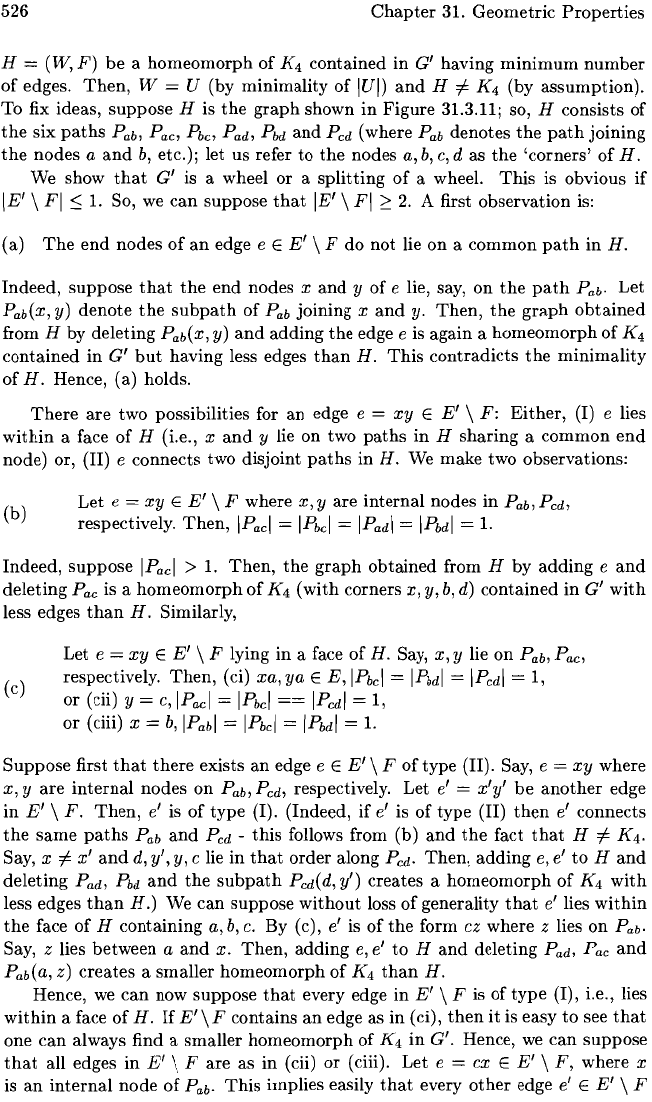
526
Chapter
31. Geometric
Properties
H =
(W,
F)
be
a
homeomorph
of
K4 contained
in
G'
having
minimum
number
of
edges.
Then,
W = U (by minimality
of
lUI)
and
H
=I-
K4 (by
assumption).
To fix ideas,
suppose
H is
the
graph
shown
in
Figure
31.3.11; so, H consists
of
the
six
paths
Pab,
Pac,
Pbc,
Pad,
Pbd
and
Pcd
(where
Pab
denotes
the
path
joining
the
nodes a
and
b,
etc.); let us refer to
the
nodes a,
b,
e, d as
the
'corners'
of
H.
We show
that
G' is a wheel or a
splitting
of
a wheel.
This
is obvious
if
IE'
\ FI
~
1.
So,
we
can
suppose
that
IE'
\ FI 2
2.
A first observation is:
(a)
The
end
nodes
of
an
edge e E
E'
\ F do
not
lie
on
a
common
path
in
H.
Indeed, suppose
that
the
end
nodes x
and
y
of
e lie, say,
on
the
path
Pab.
Let
Pab(X,
y)
denote
the
subpath
of
Pab
joining x
and
y.
Then,
the
graph
obtained
from H by deleting
Pab(X,
y)
and
adding
the
edge e is again a
homeomorph
of
K4
contained
in
G'
but
having less edges
than
H.
This
contradicts
the
minimality
of
H.
Hence, (a) holds.
There
are
two possibilities for
an
edge e =
xy
E
E'
\ F:
Either,
(I) e lies
within
a face
of
H (i.e., x
and
y lie on two
paths
in
H sharing a
common
end
node) or, (II) e connects two disjoint
paths
in
H.
We make two observations:
(b)
Let
e =
xy
E
E'
\ F where
x,
yare
internal
nodes
in
P
ab
,
Pcd,
respectively.
Then,
lPacl
=
IPbcl
=
IPadl
=
IPbdl
=
1.
Indeed,
suppose
lPacl
>
1.
Then,
the
graph
obtained
from H by
adding
e
and
deleting
Pac
is a
homeomorph
of
K4
(with
corners
x,
y,
b,
d)
contained
in
G'
with
less edges
than
H.
Similarly,
(
c)
Let
e =
xy
E
E'
\ F lying
in
a face
of
H.
Say,
x,
y lie
on
Pab,
Pac,
respectively.
Then,
(ci)
xa,ya
E
E,
IPbcl
=
IPbdl
=
IPcdl
= 1,
or (cii) y =
e,
IPacl
=
IPbcl
==
IPcdl
= 1,
or
(ciii) x =
b,
lPabl
=
IPbci
=
IPbdi
=
1.
Suppose
first
that
there
exists
an
edge e E
E'
\ F
of
type
(II). Say, e =
xy
where
x,
yare
internal
nodes
on
P
ab
,
Pcd,
respectively. Let e' =
x'y'
be
another
edge
in
E'
\ F.
Then,
e' is
of
type
(I). (Indeed,
if
e' is
of
type
(II)
then
e' connects
the
same
paths
Pab
and
Pcd
-
this
follows from (b)
and
the
fact
that
H
=I-
K4.
Say, x
=I-
x'
and
d,
y', y, e lie
in
that
order along P
cd.
Then,
adding
e,
e'
to
Hand
deleting
Pad,
Pbd
and
the
subpath
Pcd(d, y') creates a
homeomorph
of
K4
with
less edges
than
H.)
Vve
can suppose
without
loss
of
generality
that
e' lies
within
the
face
of
H containing
a,b,e.
By (c), e' is
ofthe
form
ez
where z lies
on
P
ab
.
Say, z lies between a
and
x.
Then,
adding
e,
e'
to
H
and
deleting
Pad,
Pac
and
Pab(a, z)
creates
a smaller
homeomorph
of
K4
than
H.
Hence,
we
can
now suppose
that
every edge
in
E'
\ F is
of
type
(I), i.e., lies
within
a face
of
H.
If
E'
\ F contains
an
edge as
in
(ci),
then
it
is easy
to
see
that
one
can
always find a smaller
homeomorph
of K4
in
G'. Hence,
we
can
suppose
that
all edges
in
E'
\ F are as
in
(cii) or (ciii).
Let
e =
ex
E
E'
\
F,
where x
is
an
internal
node
of
Pab.
This
implies easily
that
every
other
edge e' E
E'
\ F
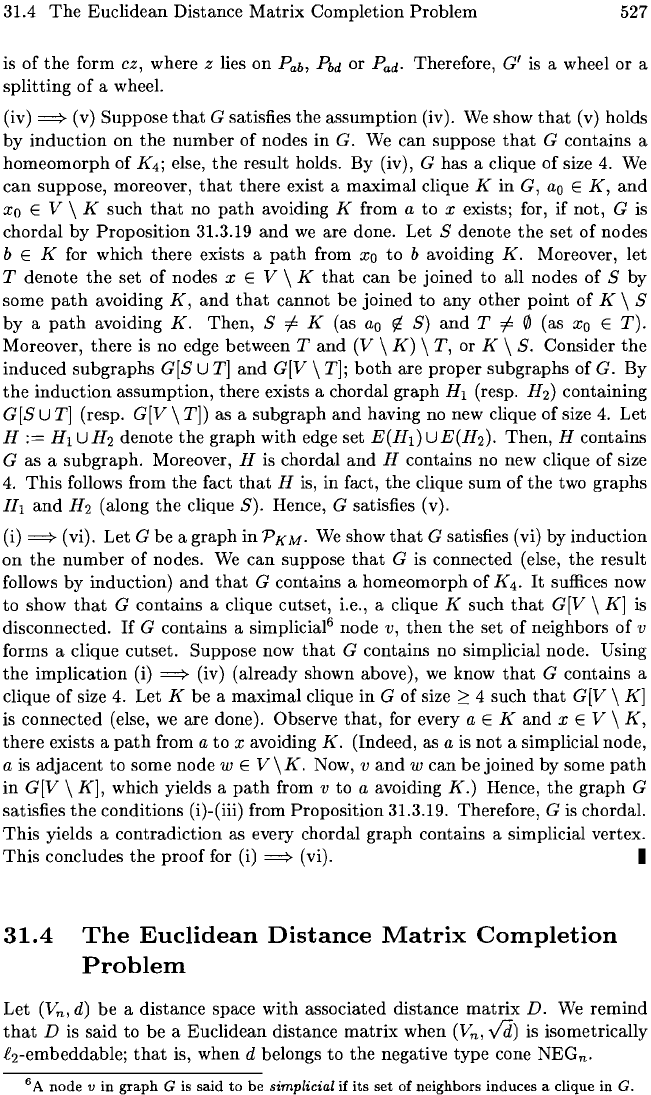
31.4
The
Euclidean
Distance
Matrix
Completion
Problem
527
is
of
the
form cz, where z lies
on
Pab,
Pbd
or
Pad.
Therefore,
G'
is
a wheel
or
a
splitting
of
a wheel.
(iv)
=*
(v) Suppose
that
G satisfies
the
assumption
(iv). We show
that
(v) holds
by
induction
on
the
number
of
nodes
in
G. We can suppose
that
G contains a
homeomorph
of
K4;
else,
the
result holds.
By
(iv), G has a clique
of
size
4.
We
can
suppose, moreover,
that
there
exist a
maximal
clique K
in
G,
ao
E
K,
and
Xo
E V \ K such
that
no
path
avoiding K from a to x exists; for, if not, G is
chordal
by
Proposition
31.3.19
and
we
are done. Let S denote
the
set
of
nodes
b E K for which
there
exists a
path
from
Xo
to
b avoiding
K.
Moreover, let
T
denote
the
set
of
nodes x E V \ K
that
can
be
joined to all nodes
of
S by
some
path
avoiding
K,
and
that
cannot
be
joined to any
other
point
of
K \ S
by
a
path
avoiding
K.
Then,
S
-I
K (as
ao
rt
S)
and
T
-I
0 (as
Xo
E
T).
Moreover,
there
is no edge between T
and
(V
\
K)
\
T,
or K \
S.
Consider
the
induced
subgraphs
G[S
U
T]
and
G[V
\
T];
both
are
proper
subgraphs
of
G.
By
the
induction
assumption,
there
exists a chordal
graph
Hi
(resp.
H2)
containing
G[S
U
T]
(resp.
G[V
\ T]) as a
subgraph
and
having no new clique
of
size
4.
Let
H
:=
Hi
U
H2
denote
the
graph
with
edge set
E(H
i
)
U E(H2).
Then,
H contains
G as a
subgraph.
Moreover, H is chordal
and
H contains no new clique
of
size
4.
This
follows from
the
fact
that
H is, in fact,
the
clique
sum
of
the
two
graphs
Ih
and
H2
(along
the
clique
S).
Hence, G satisfies (v).
(i)
=*
(vi). Let G
be
a
graph
in
PKM.
We show
that
G satisfies (vi) by
induction
on
the
number
of
nodes. We
can
suppose
that
G is connected (else,
the
result
follows
by
induction)
and
that
G contains a
homeomorph
of
K
4
.
It
suffices now
to show
that
G contains a clique cutset, i.e., a clique K such
that
G[V
\
K]
is
disconnected.
If
G contains a simplicial
6
node v,
then
the
set
of
neighbors
of
v
forms a clique cutset. Suppose now
that
G contains no simplicial node. Using
the
implication
(i)
=*
(iv) (already shown above),
we
know
that
G contains a
clique
of
size 4. Let K
be
a
maximal
clique
in
G
of
size
2:
4 such
that
G[V
\
K]
is connected (else,
we
are done). Observe
that,
for every a E K
and
x E V \
K,
there
exists a
path
from a
to
x avoiding
K.
(Indeed, as a
is
not
a simplicial node,
a
is
adjacent
to some
node
wE
V\K.
Now, v
and
w
can
be
joined
by some
path
in
G[V
\
K],
which yields a
path
from v to a avoiding
K.)
Hence,
the
graph
G
satisfies
the
conditions (i)-(iii) from
Proposition
31.3.19. Therefore, G
is
chordal.
This
yields a
contradiction
as every chordal
graph
contains a simplicial vertex.
This
concludes
the
proof
for (i)
=*
(vi). I
31.4
The
Euclidean
Distance
Matrix
Completion
Problem
Let (Vn' d)
be
a
distance
space
with
associated distance
matrix
D.
We
remind
that
D is said to
be
a
Euclidean
distance
matrix
when (Vn'
Vd)
is isometrically
l2-embeddable;
that
is, when d belongs to
the
negative
type
cone
NEG
n
.
6 A
node
v
in
graph
G is
said
to
be
simplicial if
its
set
of
neighbors
induces
a
clique
in
G.
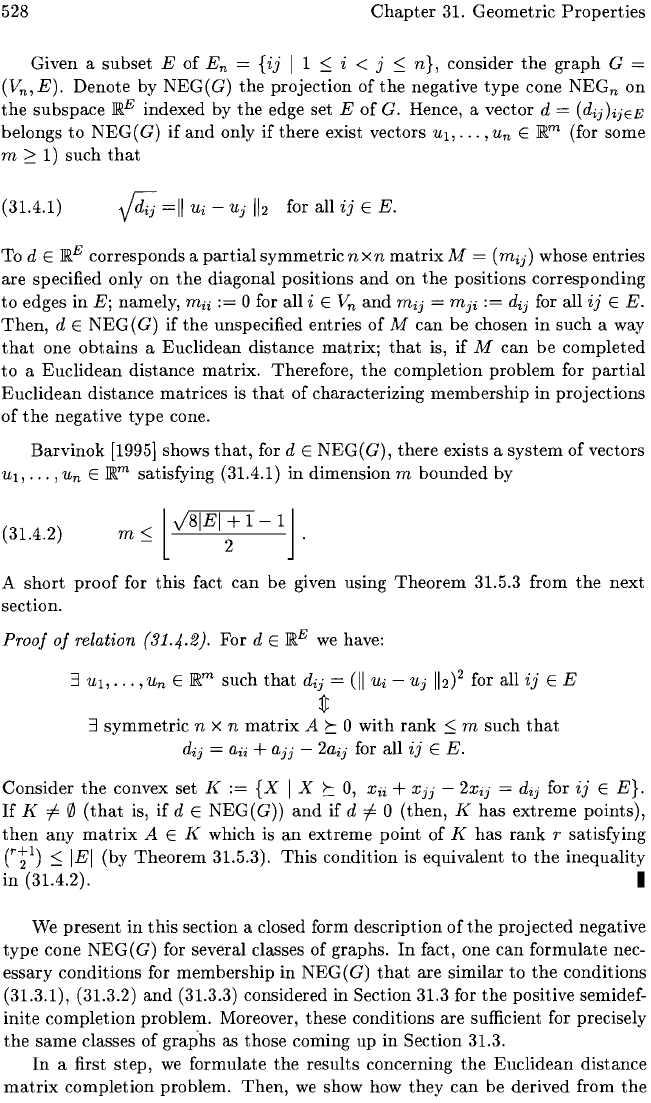
528
Chapter
31.
Geometric
Properties
Given a
subset
E
of
En =
{ij
I 1
::;
i < j
::;
n},
consider
the
graph
G =
(Vn,E).
Denote
by
NEG
(G)
the
projection
of
the
negative
type
cone
NEG
n
on
the
subspace
lm,E
indexed
by
the
edge
set
E
of
G. Hence, a vector d =
(dij)ijEE
belongs
to
NEG(
G)
if
and
only
if
there
exist vectors
Ul,
...
,Un
E
lm,m
(for
some
m:::::
1)
such
that
(31.4.1)
[i:J
=11
Ui
-
Uj
112
for all
ij
E
E.
To d E
lm,E
corresponds
a
partial
symmetric
n
Xn
matrix
M =
(mij)
whose entries
are specified only
on
the
diagonal
positions
and
on
the
positions
corresponding
to
edges
in
E;
namely,
mii
:=
0 for all i E
Vn
and
mij
=
mji
:=
d
ij
for all
ij
E
E.
Then,
d E
NEG
(G)
if
the
unspecified entries
of
M
can
be
chosen
in
such
a way
that
one
obtains
a
Euclidean
distance
matrix;
that
is,
if
M
can
be
completed
to
a
Euclidean
distance
matrix.
Therefore,
the
completion
problem
for
partial
Euclidean
distance
matrices
is
that
of
characterizing
membership
in
projections
of
the
negative
type
cone.
Barvinok
[1995]
shows
that,
for
dE
NEG(G),
there
exists a
system
of
vectors
Ul,
...
,
Un
E
lm,m
satisfying (31.4.1)
in
dimension
m
bounded
by
(31.4.2)
l
J81
EI
+ 1 -
1J
m::;
2 .
A
short
proof
for
this
fact
can
be
given using
Theorem
31.5.3 from
the
next
section.
Proof
of
relation
(31.4.2). For d E
lm,E
we
have:
:J
Ul,
...
,Un
E
lm,m
such
that
dij
=
(II
Ui
-
Uj
112)2
for all
ij
E E
1}
:J
symmetric
n x n
matrix
A t 0
with
rank::;
m
such
that
dij
=
aii
+
ajj
-
2aij
for all
ij
E
E.
Consider
the
convex set K
:=
{X
I X t
0,
Xii
+
Xjj
-
2Xij
=
dij
for
ij
E
E}.
I[
K
¥-
(/)
(that
is,
if
dE
NEG
(G))
and
if
d¥-O
(then,
K
has
extreme
points),
then
any
matrix
A E K which is
an
extreme
point
of
K
has
rank
r
satisfying
(rr)
::;
lEI
(by
Theorem
31.5.3).
This
condition
is equivalent to
the
inequality
in
(31.4.2). I
We
present
in
this
section a closed form
description
ofthe
projected
negative
type
cone
NEG(
G) for several classes
of
graphs.
In
fact, one
can
formulate
nec-
essary
conditions
for
membership
in
NEG(G)
that
are
similar
to
the
conditions
(31.3.1), (31.3.2)
and
(31.3.3) considered in Section 31.3 for
the
positive semidef-
inite
completion
problem.
Moreover,
these
conditions
are sufficient for precisely
the
same
classes
of
graphs
as
those
coming
up
in
Section 31.3.
In
a first
step,
we
formulate
the
results
concerning
the
Euclidean
distance
matrix
completion
problem.
Then,
we
show how
they
can
be
derived
from
the
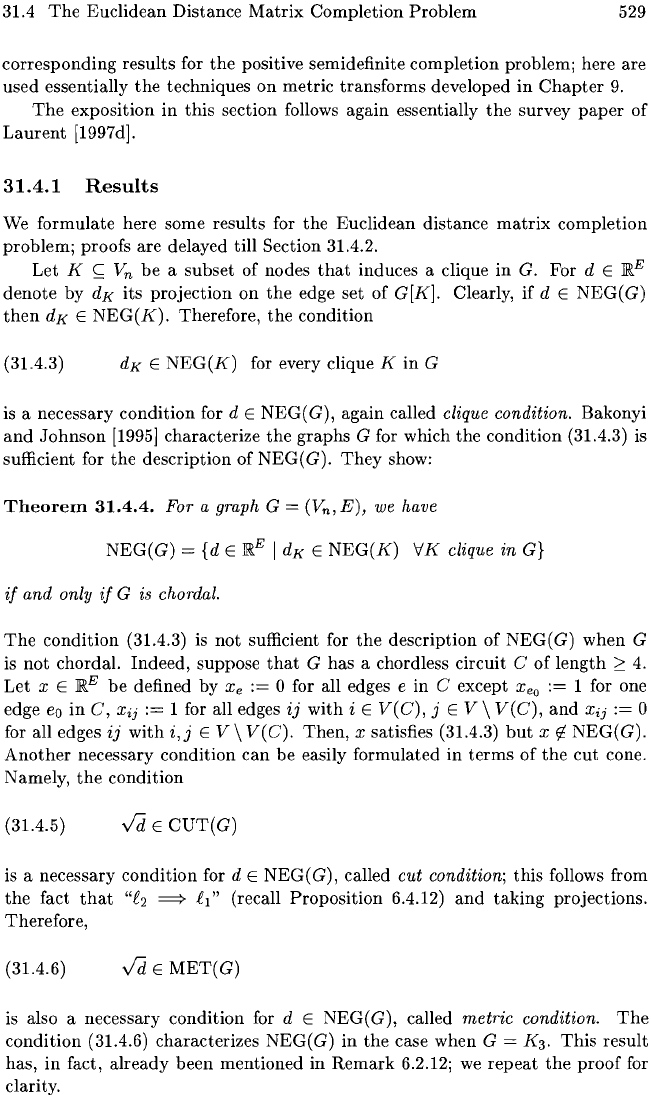
31.4
The
Euclidean
Distance
Matrix
Completion
Problem
529
corresponding
results for
the
positive semidefinite completion problem; here are
used essentially
the
techniques
on
metric
transforms
developed
in
Chapter
9.
The
exposition
in
this
section follows again essentially
the
survey
paper
of
Laurent
[1997d].
31.4.1
Results
We formulate here some results for
the
Euclidean distance
matrix
completion
problem; proofs are delayed till Section 31.4.2.
Let
K
~
Vn
be
a subset of nodes
that
induces a clique
in
G. For d E
:IRE
denote
by dK
its
projection
on
the
edge set of G[K]. Clearly, if d E
NEG(G)
then
dK E
NEG(K).
Therefore,
the
condition
(31.4.3)
dK E
NEG(K)
for every clique K
in
G
is a necessary
condition
for d E NEG(
G),
again called clique condition. Bakonyi
and
Johnson
[1995]
characterize
the
graphs G for which
the
condition (31.4.3) is
sufficient for
the
description of
NEG(G).
They
show:
Theorem
31.4.4.
For a graph G = (Vn,
E),
we have
NEG(G)
=
{d
E
:IRE
I d
K
E
NEG(K)
VK
clique
in
G}
if
and
only
if
G is chordal.
The
condition (31.4.3) is
not
sufficient for
the
description of
NEG(
G)
when
G
is
not
chordal. Indeed, suppose
that
G
has
a chord less circuit C
of
length;:::
4.
Let
x E
:IRE
be
defined by Xe
:=
0 for all edges e in C except
xeo
:=
1 for one
edge
eo
in
C,
Xij
:=
1 for all edges
ij
with
i E V(C), j E V \
V(C),
and
Xij
:=
0
for all edges
ij
with
i,j
E
V\
V(C).
Then,
x satisfies (31.4.3)
but
x
if-
NEG(G).
Another
necessary condition
can
be
easily formulated
in
terms
of
the
cut
cone.
Namely,
the
condition
(31.4.5)
v'd
E
CUT(G)
is a necessary condition for d E
NEG(G),
called
cut
condition;
this
follows from
the
fact
that
"£2
===}
£1"
(recall
Proposition
6.4.12)
and
taking
projections.
Therefore,
(31.4.6)
v'd
E
MET(G)
is also a necessary condition for d E NEG(
G),
called
metric
condition.
The
condition
(31.4.6) characterizes
NEG(G)
in
the
case when G = K
3
.
This
result
has,
in
fact,
already
been
mentioned
in
Remark
6.2.12;
we
repeat
the
proof
for
clarity.
